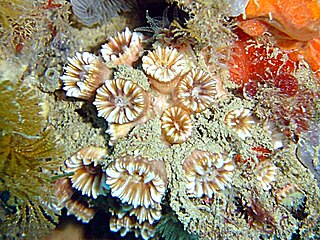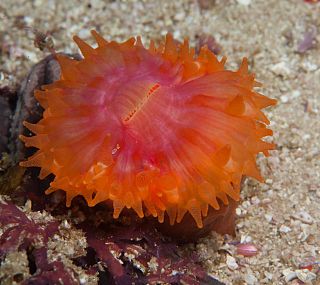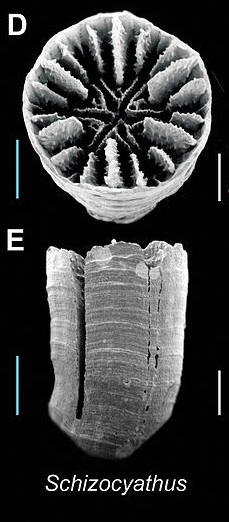
Nordmann's greenshank or the spotted greenshank, is a wader in the large family Scolopacidae, the typical waders.

Mesostigmata is an order of mites belonging to the Parasitiformes. They are by far the largest group of Parasitiformes, with over 8,000 species in 130 families. Mesostigmata includes parasitic as well as free-living and predatory forms. They can be recognized by the single pair of spiracles positioned laterally on the body.

The Caryophylliidae are a family of stony corals found from the tropics to temperate seas, and from shallow to very deep water.

Bayerotrochus is a genus of sea snails, marine gastropod mollusks in the family Pleurotomariidae.

Favia is a genus of reef-building stony corals in the family Mussidae. Members of the genus are massive or thickly encrusting colonial corals, either dome-shaped or flat, and a few are foliaceous. There is a great diversity of form even among individuals of the same species. The corallites project slightly above the surface of the coral and each has its own wall. In most species, the corallites are plocoid and in some, monocentric. The septa and costae linked to the corallite wall are well developed and covered by fine teeth. The polyps only extend and feed during the night. Each one has a small number of tapering tentacles which often have a darker coloured tip; these are called stinger tentacles, or sweeper tentacles. They use these to sweep the water to see if any other coral is in its area; if so, then they begin to sting the other coral. This is commonly known as coral war. Each coral is trying to make sure it has enough room around it so it can continue to grow and have more surface area for its offspring. The columella is parietal and spongy, and there are vesicles on both the endotheca and exotheca. Members of this genus are widespread in both the Atlantic Ocean and the Indo-Pacific.

Balanophyllia is a genus of solitary corals in the order of stony corals.

Caryophyllia is a genus of solitary corals in the family Caryophylliidae. Members of this genus are azooxanthellate and are found in the North Atlantic Ocean and the Mediterranean Sea at depths down to 2,670 metres (8,760 ft).

Cladocora is a genus of corals in the order of stony corals.

Stylaster is a genus of hydroids in the family Stylasteridae.

Dendrophyllia is a genus of stony cup corals in the family Dendrophylliidae. Members of this genus are found at depths down to about 900 metres (3,000 ft). They are azooxanthellate corals, meaning that they do not contain symbiotic photosynthetic dinoflagellates as do many species of coral.

Schizocyathidae is a family of stony corals. There are currently three genera included in this family and each of them is monotypic. Members of the family are azooxanthellate, deep water species.

Conotrochus is a genus of small corals in the family Caryophylliidae. It holds four species.

Flabellum is a genus of marine corals belonging to the family Flabellidae. These are a diverse group of azooxanthellate corals with about 190 species, 47 of which are extant. They are exclusively solitary corals and many are deep water species.
Janaria is a genus of commensal athecate hydroids in the family Hydractiniidae. It is a monotypic genus and the only species is Janaria mirabilis, commonly known as staghorn hydrocoral. It is a colonial species and lives on a shell occupied by a hermit crab. It is native to the tropical and semitropical eastern Pacific Ocean.

Heterocyathus is a genus of coral of the family Caryophylliidae.

Narella is a genus of deep-sea soft corals in the family Primnoidae (Milne Edwards, 1857). They are sessile, bottom-dwelling organisms that can be found in all ocean basins, having cosmopolitan distribution. They have a branching appearance.

Coenocyathus is a genus of cnidarians belonging to the family Caryophylliidae.

Concentrotheca is a genus of cnidarians belonging to the family Caryophylliidae.

Polymyces is a genus of corals belonging to the family Flabellidae.

Trochocyathus is a genus of corals in the family Caryophylliidae. Living species are found in waters near Hawai'i at depths of 64 to 1,020 meters. Fossil species are found as far back as the latest Paleocene in the Dilwyn Formation of Australia, in the late Cretaceous in the Woodbury Formation of New Jersey, and in Suffolk.




















